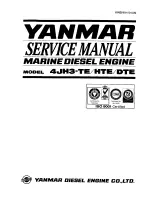
16
Note:
Valve clearances of all O.S. four-stroke-cycle engines
must be checked and reset ONLY WHEN THE ENGINE IS
COLD. Procedure is as follows.
Remove the cover from the rocker-box on top of the
cylinder-head, using the correct size Allen hex key.
1.
Turn the propeller counter-clockwise until compression is
first felt, then turn it a futher quarter revolution. At this point,
both valves should be closed. (If the prop driver ('drive
hub') of your engine is engraved with a letter 'T', this mark
should now be at the top.)
2.
The standard valve clearance, on both inlet and exhaust
valves, is between 0.04mm and 0.10mm(0.0015-0.004
inch), measured between valve stem and rocker arm. Use
the 0.04mm and 0.10mm feeler gauges to check
clearances. (See Fig.1.)
3.
Note:
If the gap is found to be less than 0.04mm, it is not
necessary to readjust the clearance if the engine has
good compression and starts easily.
Equally, if the gap exceeds
0.10mm but is not more than
0.14mm (i.e. the thickness of
both feeler gauges inserted
together), it is not essential to
readjust the clearance if the
engine runs satisfactorily.
Fig.1
If a clearance is found to be outside either of these limits,
it should be reset as follows.
Carefully loosen the locknut
on rocker-arm 1/4-1/2 turn
with 5mm wrench.
(Fig.2.)
1.
2.
3.
Locknut
Wrench
Loosen approx.
1/4 to 1/2 turn.
Turn adjusting-screw approx.
1/2 turn counter-clockwise to
open gap, using appropriate
tool -i.e. Allen hex key.
(Fig.3.)
Fig.2
Fig.3
Fig.4
Adjusting
Screw
Turn approx.
1/2 turn.
Allen Key
Insert 0.04mm feeler gauge
between valve stem and
rocker-arm and gently turn
adjusting screw clockwise
until it stops.(Fig.4.)
0.04mm Feeler
Gauge
Turn with fingers
until it stops.
0.04mm
Feeler Gauge
Rocker Arm
Valve
17
Re-tighten locknut while
holding adjusting screw
stationary. (Fig.5.)
4.
Hold at the
screw head.
Fig.5
Tighten
Locknut.
Remove 0.04mm feeler,
rotate prop through two
revolutions and recheck
gap.
5.
If clearance is correct, loosen the locknut on the other
rocker-arm and repeat steps 1 to 5 above. Finally, replace
rocker box cover.
6.
Remember:
Excessive valve clearance will cause loss of power, due
to valve (s) not opening sufficiently. On the other hand, a
total loss of clearance may cause difficult starting due to
valves not closing properly, resulting in loss of
compression.
CARE AND MAINTENANCE
Please pay attention to the matters described below to ensure
that your engine serves you well in regard to performance,
reliability and long life.
As previously mentioned, it is vitally important to avoid
operating the engine in conditions where dust, disturbed by
the propeller, may be deposited on the engine and enter its
working parts. Also, remember to keep your fuel container
closed to prevent foreign matter from contaminating the fuel.
Do not forget to clean the fuel filters periodically and, from
time to time, unscrew the complete needle-valve assembly
from the carburettor and remove any foreign matter that has
accumulated in this area.
If these precautions are neglected, restriction of fuel flow may
cause the engine to cut out, or the fuel/air mixture to become
too lean causing the engine to overheat.
The use of modern high-performance alcohol based model
engine fuels, while promoting cooler running, improved anti-
detonation combustion and increased power, have the
disadvantage of causing bottom end corrosion in a four-stroke
engine. This is due to the acidic by products of combustion that
accumulate in the engine's crankcase and are not flushed out
by fresh air/fuel mixture as in the case of a two-stroke engine.
The use of nitromethane in the fuel can also contribute to the
problem. As noted earlier, the FS-70S
Ⅱ
, FS-91S
Ⅱ
and FS-
91S
Ⅱ
-P have their most vulnerable components protected
against such attack but, as a primary defence, users are
advised, once again, to avoid running the engine on too lean a
mixture and by making sure that the engine is purged of
contaminants as much as possible.

































